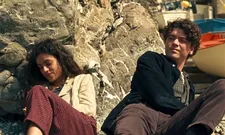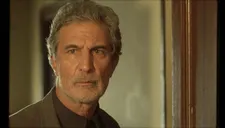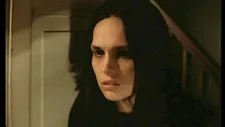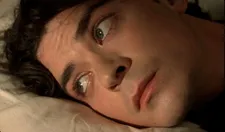Sara Fgaier’s Weightless (Sulla Terra Leggeri), a highlight of Cinecittà and Film at Lincoln Center’s 24th edition of Open Roads: New Italian Cinema, stars Andrea Renzi, Sara Serraiocco, Emilio Scarpa, and Lise Lomi. The story by Fgaier and Sabrina Cusano, who both co-wrote the screenplay with Maurizio Buquicchio, links love and memory and in an exciting new cinematic way combines past and present, the life of the mind and that of physical remnants of what may never have been.
 |
| Lise Lomi and Emilio Scarpa star in Sara Fgaier’s Weightless |
Fgaier chose a Julian Barnes quote from Levels of Life as epigraph: “We live on the flat, on the level, and yet - and so - we aspire. Some soar with art, others with religion; most with love. But when we soar, we can also crash.” A man, whom we will later get to know as Gian (Andrea Renzi) walks through a corridor and closes a door. The camera is blurry and becomes un-blurred and sharp on the man’s face. He is at a wake, but whose? He seems as confused as we are. People come by and hug him, he leaves and takes a seat on a sofa.
His daughter Miriam (Sara Serraiocco) and her little son Elyas (Elyas Turki) will be staying with Gian, who seems to have decided, consciously or not, that amnesia is the way for him to go in this moment. Weightless lifts us out of the restraints of linear time and thus any conventional flashbacks. As the camera floats over objects, over instruments, into the sky, past an old steamship out onto the ocean and through flashes of colour, there will be a beach and steps of a mule track. A younger man, a younger Gian (Emilio Scarpa) is seen in photographs with a woman (Lise Lomi).
Two people, deeply and instantaneously infatuated, agree to meet again in five months in Tunisia at the lighthouse, but life has other plans. The glorious cinematography by Alberto Fasulo and the well-placed score by Carlo Crivelli invite the mind to wonder at just the right spots. Fgaier uses archival footage, organically interspersed into the layers of one grieving man’s life, to elevate the narrative into the realm of universal validity.
 |
| Sara Fgaier on Gian (Andrea Renzi): ”During the story the only way to rediscover himself and his identity is through the research of Leila.” |
Anne-Katrin Titze: First of all, you made a beautiful film! I was particularly interested in the connection you make between memory and weightlessness. And flight, lifting up! Can you talk about the main concept?
Sara Fgaier: Thank you so much for the question! In the film I try to replicate the metaphor between flight and love. A metaphor of a motion that lifts us up and then brings us down.
AKT: You have this already with the Julian Barnes quote at the start of the film!
SF: Yes, his book [Levels Of Life] was a great inspiration for me. In the film the first meeting with Leila, his beloved, is something that now in the present he discovers himself through being in love with someone. Because he does not recognise himself. So he turns to the diary and starts to discover a person who is like a stranger for him. During the story the only way to rediscover himself and his identity is through the research of Leila. It’s the only way to save himself. It’s at the point that the diary is finished, that he decides to continue this research because it’s the only way to save himself and be able to accept the loss of Leila and be a father for his daughter.
AKT: And to enter the closed room as well!
SF: Yes!
AKT: Almost like a forbidden room, as in Bluebeard, where past secrets are stored.
 |
| Sara Serraiocco as Miriam |
SF: Yes, exactly! Because at the beginning of the film we saw him close this door. Well, it’s really the amnesia. He doesn’t accept the loss of her and he starts to leave this dimension of loss, of grieving alone. He hides it from himself. I think it’s one of those situations in life that is impossible to live alone. We need to be with other people. It’s an experience that is necessary to be lived in a collective dimension. That’s why I put all the rituals in the film. The ones that aid him at that moment.
He arrives at the realisation that it’s possible to still have Leila inside of him. And the carnival or the rituals in North Africa are situations in which you can see the thread between life and death. Is it possible to have a dialogue with the invisible? Gian starts to think that as long as he lives, Leila will keep living inside himself.
AKT: It’s interesting what you say about rituals. They are what physically connects us to the past. Connecting with ancestors, with the dead in a way.
SF: Exactly, there is a representation of death in our society, in our contemporary world, in which the dead are like a taboo. It was so strong for me to assist with these rituals because there are people who make the dead in representation. It’s really about the dead and the possibility to be reborn and to live. And the story is about that. That you can also disappear but is it possible to have a second chance, thanks to a change of perspective?
 |
| Sara Fgaier on Weightless: “In the film I try to replicate the metaphor between flight and love.” |
AKT: What’s great is that at the beginning of the film, we are in his position. We don’t know any of the people. We don’t know why he is at this wake and wonder whose funeral it is. So we also look at all the different women, thinking if they could be her.
SF: I’m pretty happy about that because I love to put the public in exactly the same situation as Gian. It’s not a reconstruction of the past, it’s really a discovering of the past. And we make this discovery with him. So when there are these different women he is thinking, is she it? Or the other one? And we have the same questions.
AKT: The archival footage mixed in alerts us to the fact that this is cinema. And cinema brings us ghosts from the past.
SF: It was a way to explore the ghost of Leila of course, but also at the beginning to try to create a past for someone that had lost his memory and use archive as a way to construct a possible past. And that is not a single memory but something that is archetypical, so that everyone can feel involved in these kind of images. It was also really important for me to create a dimension of time as the one that Gian leaves because he is a man that lives in no time. So there’s images from the past, hallucinations, phantasmagorical images. I really wanted to mix the era of this story.
 |
| Emilio Scarpa as a younger Gian |
There is an era of this story but I decided not to describe it exactly. Because the feeling for me that was important to describe was being in flux. To put the public in the same situation as Gian and also try to create the fact that it’s difficult for him. There are no classical flashbacks in the film and the important thing for me was to mix with archival material and also what we shot in the first scene of the past, the beach, to try to create images with these difficulties. To place the public in the same dimension of mental images that are unconscious.
AKT: There is a moment when they decide to meet five months later.
SF: It’s crazy.
AKT: It reminded me of two things. One is the story of The Good Soldier Švejk, a Czech book I vaguely remember, where two soldiers make a date to meet after the war at 5 o’clock. Of course nobody knows when the war will be over. The other was An Affair To Remember, the Leo McCarey film with Cary Grant and Deborah Kerr. They meet on an ocean liner and make a date for the Empire State Building?
SF: Yes, of course, An Affair To Remember! There are two films!
AKT: Yes, two versions by McCarey [Love Affair in 1939 with Irene Dunne and Charles Boyer and An Affair To Remember in 1957].
 |
| Arriving at The Leopard at des Artistes for the Open Roads: New Italian Cinema luncheon Photo: Anne Katrin Titze |
SF: I saw the two versions in Paris. It was incredible, because I already wrote the film and then I discovered them. Yes, there is the appointment at the Empire State Building and here the impossibility to meet - it was the same. He was there. It was for me also a way to let Gian in that situation accept something completely crazy for someone who fell in love. Wait for five months when you want to meet the other person tomorrow or the day after. It’s also something connected to his fear to enter in his life really. Because he knows that there is another person, so it’s also another way to maintain this idealistic love. A little bit narcissistic also because it’s something that is really romantic but not real.
AKT: Like An Affair To Remember.
SF: Exactly, so it’s like a myth. I think we can act like that without being really conscious about that. We repeat something in our life, the fact that maybe it’s only out of fear and not just to have the ideal love. The extreme side of that would be the amnesia. Something that’s too much.
AKT: To live it!
SF: To live it, yes!
AKT: A detail I noticed in the cemetery meeting place - the doves loved one grave and all gathered there. Was it coincidence or did you put something there?
SF: There is a spot for water and also seeds for the birds. It was something that really surprised me when I discovered this place. Because flight is one of the themes of the film.
 |
| Sara Fgaier on including the audience in Gian’s quest: “We make this discovery with him. So when there are these different women he is thinking, is she it? Or the other one?” |
AKT: Exactly!
SF: So it’s normal to have a lot of birds!
AKT: One last question, because there is also the Monica Vitti series going on. Are you a fan of Monica Vitti’s work?
SF: Yes, I really like Monica Vitti. She’s one of my favorite actresses. She was a great great actress. The films with Antonioni! The one I saw last year was La Notte.
AKT: Oh yes, with Marcello Mastroianni and Jeanne Moreau. It’s fantastic.
SF: It’s amazing!
AKT: Thank you! See you at the luncheon!
SF: Thank you! See you there!








![Sara Fgaier on Leo McCarey’s An Affair To Remember, starring Deborah Kerr and Cary Grant and Love Affair with Irene Dunne and Charles Boyer: “I saw the two versions in Paris. It was incredible, because I already wrote the film [Weightless] and then I discovered them.”](/images/newsite/Sara_Fgaier_600.webp)













